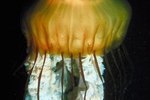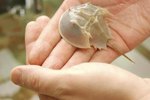
To a naïve shark, grouper or eel swimming through a coral reef, an octopus looks like an easy meal. Unfortunately for the would-be predator, octopuses are protected by a variety of defensive adaptations. While trying to escape, the octopus may jet through the water, mimic another animal, or change its color to blend in with the substrate. If none of these tactics work, the octopus will eject a thick cloud of black ink into the water and disappear amid the distraction.
Octopus Basics
Octopuses are cephalopods, like their cousins the squid, cuttlefish and nautiluses. Octopuses have eight long arms, covered in small suckers; they use these arms to grasp prey and bring it to their beak-like mouths. Octopuses are very intelligent animals; cephalopods have the largest brains of any invertebrates. The brain represents a higher percentage of body weight in an octopus than in many fish and reptiles. While some cephalopods—such as nautiluses—live long lives, octopuses are short-lived creatures that seldom exceed 3 years of age.
Cephalopod Ink
When threatened, many species of octopuses—as well as most other cephalopods—will discharge a cloud of dark ink. The ink is composed primarily of melanin, which is the same pigment that darkens the skin of humans and many other animals. It also contains tyrosinase, a substance that irritates potential predators' eyes and disrupts their sense of smell. Under cover of this irritating, camouflaging ink, the octopus can often escape.
The Human Use of Ink
Though the term "sepia ink" is currently used to describe any number of reddish-brown inks, it originally referred solely to ink derived from cuttlefish. After drying and then grinding the ink sac and its contents, the preparers then mix the powder with shellac before packaging it for sale. Cephalopod inks are often used to color or flavor pasta and other foods as well.
Additional Defensive Mechanisms
In addition to using ink, octopuses have a plethora of other defensive tactics. They often use different defense mechanisms in conjunction with one another. For example, an octopus may attempt to flee an attacker by jetting away, and then try to camouflage itself on the sandy bottom. If these techniques fail, it may temporarily turn black, eject a cloud of ink, and then change to a different color before trying to slip away. Some, such as the blue-ringed octopuses (Hapalochlaena spp.), harbor bacteria in their mouths that produce powerful toxins, making a bite from one of these creatures potentially lethal to humans. As a final tactic, some octopuses may shed one of their arms to distract a predator, much as some lizards shed their tails.
References
- The Octopus News Magazine Online: Is Octopus Ink Similar to Fountain Pen Ink?
- National Geographic: Common Octopus
- World Animal Foundation: Octopus Fact Sheet [PDF]
- Communicative and Integrative Biology: A New Perspective on the Organization of an Invertebrate Brain
- Squid-Ink.us: About Squid Ink
- The Biological Bulletin: Escape by Inking and Secreting: Marine Molluscs Avoid Predators through a Rich Array of Chemicals and Mechanisms
Resources
Photo Credits
-
Comstock Images/Comstock/Getty Images




